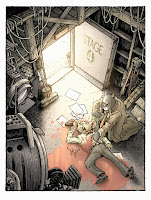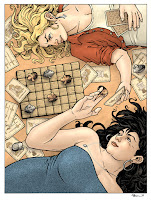Last year I was asked by Wizards of the Coast to do some Magic the Gathering card art for their upcoming animal set Bloomburrow (
https://magic.wizards.com/en/products/bloomburrow). I played a lot of MtG back in the mid/late 90's, so it was an honor and thrill to become a part of the fraternity of MtG illustrators.
The final card of mine from Bloomburrow that was revealed is Azure Beastbinder.
The set was released in early August, and I'm happy to share the artwork and process for creating it.
The process started with the brief from my art director asking for a Ratfolk rogue sliding underneath a Calamity Beast slicing its underbelly with a dagger that turns the wound into blue smoke or vapor. WotC provided me with an enormous PDF with reference for the rats and their clothing (In this case they asked specifically for japanese Aizome triangular patches) and weaponry for Bloomburrow, as well as reference for the Calamity Beast.
I started with a rough version of the rat in a power slide pose and did a few versions before I put it on a lightpad to draw it out more tightly and add in all the clothing details as well as the dagger. Before I drew the Calamity beast in pencil, I think I scanned in the rat, then painted a blocky mass where I wanted the creature, then printed that out to do the drawing seen here.
The pencil roughs were all assembled and combined digitally in Photoshop. For the magic vapor wound I painted with a cyan color in Photoshop and had a stroke applied to that layer to give me an outline.
At this stage, I also like to do a preliminary digital color blocking, to make sure I have the color and value tangents worked out, and also to show my art director at WotC so they are on the same page as I am (no one likes surprises in the later stages of a commissioned art piece). This is the stage where I can also easily make adjustments moving a character or resizing something.
With the pencils/layouts approved by my art director, Aliana Rood, I moved on to inks. I printed the digital composite out and taped it to the back of a sheet of Strathmore 300 series bristol. On my Huion Lightpad, I was able to see through the surface of the bristol to use the printout as a guide as I inked with Copic Multiliner SP pens. I did more texture on this card than any of my others, but I think it works in the end with color.
The inks were then scanned back into Photoshop where I could start the coloring process. This stage. called flatting' is the professional version of coloring-in-the-lines. Just flat color is placed in to establish everything's base colors. the art director also liked when my linework was softer in my Mouse Guard work, and wanted everything to have a dark brown color hold (ink lines colored to be something other than black). I also established other color holds on the vapor wound and the rocky background.
Here are the final rendered colors for the art (sans card borders). I did the light and shadow and texture by using the dodge and burn tools in Photoshop with a stock textured brush.
I have prints of this piece available for sale:
https://mouseguard.bigcartel.com/category/magic






























